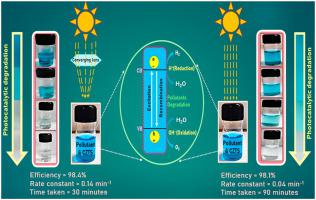Journal of Materiomics ( IF 9.4 ) Pub Date : 2021-04-20 , DOI: 10.1016/j.jmat.2021.04.005 Pooja Semalti , Vikash Sharma , Shailesh Narain Sharma

|
CZTS (Cu2ZnSnS4), a P-type semiconductor with a direct bandgap (1.2–1.7eV), earth-abundant, non-toxic, and has a large absorption coefficient makes it extremely useful in optoelectronics and light-harvesting applications. In this work, CZTS is prepared by an ingenious, cost-effective colloidal route using the ‘hot-injection’ method with the usage of different ligands. The XRD and Raman spectroscopy shows the single-phase highly crystalline CZTS nanoparticles with kesterite structure. The TEM results show that the size of CZTS nanoparticles is about 2–5 nm and monodispersity is confirmed by DLS (Dynamic Light Scattering). FTIR confirms the presence of different ligands used in CZTS preparation. The Uv–vis absorption shows the direct bandgap of 1.5–1.7eV. The contact angle study shows the hydrophobic nature of as-synthesized CZTS nanoparticles which were further ligand exchanged with l-cysteine hydrochloride to make it hydrophilic to study the photocatalytic degradation activity of organic pollutants and industrial waste in the water. The photocatalysis experiments were performed under two conditions: (i) under bare sunlight (Intensity ∼ 900 W/m2) (ii) focussing the sample under the sunlight via converging lens (1800 W/m2). The photocatalytic efficiencies were then compared and the best photocatalytic efficiency achieved under sunlight was 98.4% for organic pollutants and 75% for industrial waste via converging lens while the corresponding efficiencies with bare sunlight were 98.1% and 73% respectively. To the best of the author’s knowledge, a rapid and highly efficient photocatalysis of CZTS NPs employing a converging lens for water-remediation without the usage of noble & transition-metals has been reported for the first time.
中文翻译:

一种溶液法处理CZTS纳米晶水体修复有机污染物和工业废物的新方法
CZTS (Cu 2 ZnSnS 4),一种具有直接带隙 (1.2-1.7eV) 的 P 型半导体,地球上含量丰富,无毒,并且具有大的吸收系数,使其在光电子学和光收集应用中非常有用。在这项工作中,CZTS 是通过使用不同配体的“热注射”方法通过巧妙、经济高效的胶体途径制备的。XRD 和拉曼光谱显示具有锌黄锡矿结构的单相高结晶 CZTS 纳米粒子。TEM 结果表明 CZTS 纳米粒子的尺寸约为 2-5 nm,单分散性由 DLS(动态光散射)证实。FTIR 确认了 CZTS 制备中使用的不同配体的存在。紫外可见吸收显示直接带隙为 1.5-1.7eV。l-半胱氨酸盐酸盐使其亲水以研究水中有机污染物和工业废物的光催化降解活性。光催化实验在两种条件下进行:(i)在裸露的阳光下(强度 ∼ 900 W/m 2)(ii)通过会聚透镜(1800 W/m 2)在阳光下聚焦样品。的光催化效率然后比较并在阳光下达到的最佳的光催化效率是有机污染物98.4%和75%的工业废物经由会聚透镜,而在裸阳光下对应的效率分别为 98.1% 和 73%。据作者所知,首次报道了使用会聚透镜在不使用贵金属和过渡金属的情况下快速高效地光催化 CZTS NPs 进行水修复。



























 京公网安备 11010802027423号
京公网安备 11010802027423号